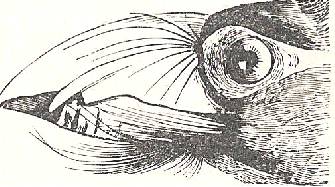|
|
|
The word Barbet had long existed in French
in the sense of a shaggy dog - a poodle or water-spaniel. Applied
to birds, it was Pennant's equivalent in 1773 (Gen. Birds, pp. 13,
14) of Brisson's and subsequently Linnaeus's genus Bucco (a word
coined (from the latin bucca ; and, as explained by Pennant, referring
to "the fulness of the cheeks".) in 1752 by Moehring, though applied by
him to the TOUCANS); but Brisson called it in French Barbu, "from
its bristles, a sort of beard" with which the beak is beset, as can be
seen in the picture on this page, and hence Pennant formed his word
|

Pogonorhynchus
|
The type of Brisson's genus, on which that of Linnaeus
was founded, was called by the latter in 1766, Bucco capensis - most
unhappily in all respects, for the former had expressly given Cayenne
as its habitat (In this case of the use of the extraordinary and ungrammatical
adjective which has unfortunately been so frequently adopted, one can hardly
doubt that Linnaeus meant to write, and very likely did write (in an abbreviated
form, as was his habit),
Cayensis
for cayennensis, which
he afterwards misread, and unluckily clenched the mistake by adding "Hab.
ad. Cap. b. Spei")). The birds originally included in the genus are now
recognized as belonging to two distinct Families, commonly known as Bucconidae
and Capitonidae,
and it is to the latter of these that
the name"Barbet" is restricted by modern ornithologists, the former being
known as PUFF-BIRDS.
The
Capitonidae, or "Scansorial" Barbets
as some authors designated them, though their climbing power is disputed,
formed the subject of a beautifully illustrated
Monograph by Messrs.
C. H. T. and G. F. L. Marshall (London: 1870-71), who divided the Family
into three subfamilies :-Pogonorhynchinae,
with 3 genera and 15
species; Megalaeminae, with 6 genera and 44 species; and Capitoninae,
with 4 genera and 18 species. Since the appearance of that work one
new genus and some thirty new species have been described. If the subfamilies
above named had been be truly established, it would seem that the Capitoninae,
of which members are now to be found in the New World as well as in
Africa and Asia, may from its wide distribution be regarded as the most
ancient, and next the
Pogonorhynchinae, inhabiting both America
and Africa, while the
Megalaeminae, restricted to Africa and Asia,
appears to be the most modern subfamily, and two genera belonging to
it, Megalaema (which appears to be equivalent to the modern
21st Century spelling of the genus Megalaima) and
Xantholaema
were said to be found in India and Ceylon in the 19th Century.
|
Megalaima
They are birds mostly of a bright green plumage, some
of them variegated, especially on the head, with scarlet, violet,
blue, or yellow-though others are plainly coloured. All of them
seem to live chiefly on fruit, but insects occasionally form part
of their food, and in captivity they become carnivorous. They breed in
holes of trees, laying white eggs, and most, if not all of them,
utter a clear ringing note, so loud as to attract general attention.
|
|
|





